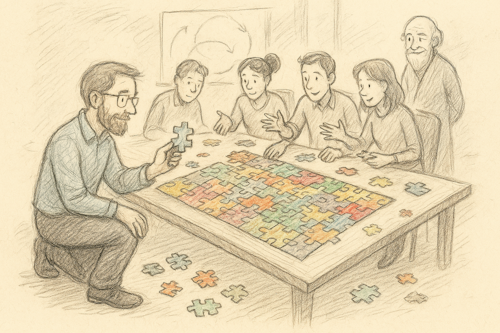The Scrum Master's Puzzle
Illustrates System Thinking, Understanding the Big Picture

A Scrum Master was once gifted a beautiful puzzle box by a wise mentor. It contained 100 unique pieces with no picture on the front and no instructions. Every day, the Scrum Master would sit quietly, trying to put the puzzle together. Pieces would seem to fit, only to fall apart later. Team members would come by and offer suggestions: “Start with the corners!” “Group by color!” “Just force the pieces to fit!”
Despite all the advice, the Scrum Master never rushed. Instead, they listened carefully, tried different combinations, and watched how the team interacted around the puzzle. Over time, they noticed patterns in how the pieces responded to each other. They stopped focusing on solving the puzzle alone and started facilitating others in trying it too. One day, the team gathered, connected the pieces together naturally, and the puzzle revealed a dynamic mosaic, not a fixed picture, but a shifting pattern that changed with every Sprint.
When the mentor returned, the Scrum Master asked, “What was the puzzle supposed to be?” The mentor smiled and said, “Exactly what you made it. The goal was never to complete it, but to learn how to see it come alive through the team.”
This parable reflects the role of a Scrum Master in Agile teams and organizations. The puzzle represents the complexity of team dynamics, product delivery, and organizational change. There is no single correct way to "solve" the puzzle because each team, product, and environment is unique.
The Scrum Master begins by trying to "solve" the team's challenges directly but eventually shifts toward facilitation, coaching, and enabling self-organization. Just like in Agile, success is not about controlling outcomes but about fostering conditions for emergent solutions.
Lessons Learned
There Is No One-Size-Fits-All Solution
Agile teams are complex systems influenced by personalities, context, constraints, and culture. The puzzle box with no picture reflects how there is no universal pattern or playbook that works in every environment. Scrum Masters must shift from being prescriptive to being adaptive. What works for one team might fail for another. It's more important to help the team understand why something works than to just hand them a framework.
Facilitation Is More Powerful Than Direction
Initially, the Scrum Master in the parable tries to solve the puzzle alone. But the breakthrough comes when they stop doing and start enabling, giving space for the team to collaborate and learn. Facilitation creates space for team ownership. A team that finds its own solution will always outperform a team waiting to be told what to do. Your role is to create structure, clarity, and psychological safety, not to hold the marker.
Progress Is Emergent, Not Linear
The mosaic doesn't come together in straight lines. Some pieces fit, others don't. Some progress falls apart before it leads to new insight. That's exactly how Agile delivery works. Teams often feel frustrated when things don't follow a perfect plan. The Scrum Master helps reframe that, it's not failure, it's feedback. Agile is built on iteration, not precision upfront.
Scrum Masters Serve The Team, Not The Process
The team in the parable makes the puzzle come alive. The Scrum Master's role is to notice, nudge, and nourish that process. They aren't enforcing a framework, they're enabling the team's evolution. Rigidly applying Scrum ceremonies and mechanics misses the point. A good Scrum Master makes the invisible visible, helping the team see themselves, inspect their process, and improve together.
The Puzzle Is Never Complete
The mosaic continues to shift. That's the nature of complex work and adaptive systems. The Scrum Master's job is not to finish the puzzle, but to help the team continuously explore, learn, and improve. There is no “done” when it comes to Agile maturity. The mindset is one of continual refinement. Even high-performing teams benefit from coaching, feedback, and time to reflect.
Coaching Tips
- Treat Ambiguity as an Opportunity: When there's no clear picture of what “done” looks like, resist the urge to control. Ask powerful questions like, “What does success feel like for us this Sprint?” or “What outcomes are we hoping to influence, not just deliver?”
- Shift from Solving to Sensing: Instead of jumping in to fix team challenges, observe behaviors, listen deeply, and identify patterns over time. This builds trust and allows sustainable change to emerge.
- Build Puzzle-Solving Capacity, not Dependence: Scrum Master's role isn't to put the pieces together yourself, but to create the conditions where the team becomes great at doing it themselves. Coach team members to ask each other for help. Encourage small experiments they lead on their own.
- Embrace the Messy Middle: Growth often looks chaotic mid-puzzle. Normalize it. Remind the team that confusion and friction are part of becoming high-performing.
- Make Learning Visible: Just as the puzzle becomes clearer over time, so does team maturity. Capture learning and insights, not just velocity or throughput.
The Scrum Master's Puzzle reminds us that agility is not about assembling a perfect picture. It is about creating the conditions where learning, collaboration, and clarity grow over time. The Scrum Master does not solve the puzzle for the team but becomes the person who helps the team see how the pieces fit together. This happens not through force, but through patience, curiosity, and trust in the process.
Like the puzzle, every team is different. There are no shortcuts, no fixed instructions, and no guaranteed outcomes. But when a Scrum Master focuses on serving the team, the team begins to find its rhythm. They start shaping their own mosaic, one that is living, flexible, and always changing. That is the real work. That is the heart of agility.


